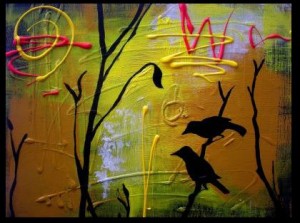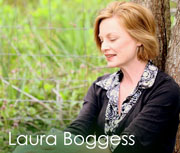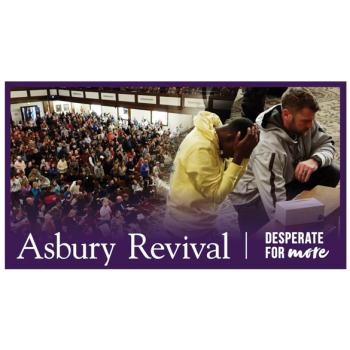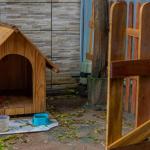“The purpose of art and religion are the same,”Kenyon Adams said. I held my breath and leaned onto the edge of my seat. “Transformation.”
I was sitting in a workshop at a conference in the middle of February, one of the oldest faces amidst a sea of college students. It wasn’t the first time I’d attended a breakout session led by Adams, a performing artist and arts advocate currently pursuing graduate studies in theology and art at Yale Divinity School. But this one, entitled Negotiable Spaces: Art, Religion and the Gift of the Liminal, was speaking to my very heart.
“Art creates space,” he said. “Effective art creates a liminal space which is shaped by our sensual engagement …”
That word, “liminal?” It means “threshold.” Adams (who has a very impressive biography) was telling us that art creates a doorway that, when stepped into, takes us to a new place where transformation is more likely to occur. In the material world, Adams explained, we all have “aspirational concerns”—we hope to be something. “In performance,” he said, “we embody these ‘hoped for’ states … if transformation occurs; this is the work of the Spirit.”
Lost
Artists played a critical role in the early history of the Church—their work evoking longing and enhancing worship for many years. However, the Protestant Reformation in the 16th Century and the Enlightenment in the 17th and 18th centuries led to suspicion of emotional and sensual experiences. During this time the Church came to associate art with idolatry and irrational thinking and thus distanced itself from most forms of artistic expression. In doing so, we lost a powerful means of transformation. We have been seeking to recover art for the Kingdom ever since.
In the first of a series of lectures by International Arts Movement (IAM) founder Makoto Fujimura on “Art, Love, and Beauty,” Fujimara discusses why he feels creativity has been “culturally orphaned” and the dangers of this for our world. Fujimura says that one of the things they try to do at IAM is “…wrestle deeply with issues of art, faith, and humanity…” The fourth live broadcast in a series of six is scheduled for March 20, 2014, and is entitled “Art as Prayer”.
IAM and similar organizations have done a lot to encourage the restoration of the relationship between faith and art. The Church today is more comfortable embracing the arts but it remains an important question: How do we carry this liminal space that art creates into the church, into ministry?
Found
This conversation between faith and art has been explored in a series at TheHighCalling,org on visual and creative arts as ministry.

In an interview with Christine Scheller, actor Forest Whitaker talks about how faith influences his work.
It’s more about my connection with other human beings, my connection with God. It is a motivating factor in my work. It is what I do in my acting. The way I try to explore a character is a spiritual journey for me. It’s not an academic or theatrical journey. It’s a journey to try to get to an understanding of my connection with another human being who is also divine in their connection with God.
Whitaker also discusses how his Southern Baptist roots are a factor in the many humanitarian projects he is involved in, stating, “I have a deep connection to that with my family. My father is an elder in the church. He’s a minister, so it’s something that I know. I understand and I think it’s influenced the way I make all my choices.”

Sometimes art can build a bridge and create opportunities to impact lives in deeply intimate ways. Author, speaker, and artist Emily Wierenga shares a story of how she has uses art to connect with young girls in her community. “Art gives us permission to be human in a way that most humans cannot,” Emily writes. “Because art doesn’t judge. It invites.”
The art we make can be a way of loving—both ourselves and others. What greater ministry is there than love? Writer Diana Trautwein experienced this firsthand during a season of working as a florist.
The more I learned, the more I began to see how this form of visual art added beauty that went beyond the senses. Seeing the lilies and roses, the bouvardia and star aster add color and fragrance to those ceremonies and gatherings, I began to think of my work as an offering of sorts. A gift to the couples, to friends, to family. A ministry.
In one of our daily reflections, Christy Tennant Crispin acknowledges how art brings liturgy to life during worship.
The artists among us know this to be true: words are often not enough. For many, the message only comes alive when it is embodied in a physical form: paint, wood, cement, bronze. Words sometimes pass right over a person’s head, while images are ingrained into minds—and hearts.
 When we look for more conversation on this topic, The International Arts Movement is a wonderful resource. IAM talks with Alfonse Borysewicsz in one of their featured videos about his exhibit “The Beekeeper Paintings.” In the video, the author discusses how faith enriches his art and describes his attempts to restore the Church’s connection to the arts through various projects.
When we look for more conversation on this topic, The International Arts Movement is a wonderful resource. IAM talks with Alfonse Borysewicsz in one of their featured videos about his exhibit “The Beekeeper Paintings.” In the video, the author discusses how faith enriches his art and describes his attempts to restore the Church’s connection to the arts through various projects.
One church that seems to be doing a good job of integrating faith and art is Redeemer Presbyterian Church in New York City. Their Center for Work and Faith is the “cultural renewal arm” of that church. Their vision inspires. Redeemer’s Art’s Ministry has developed a series called In the Living Room that “offers artists discipleship, informal theological training, as well as encouragement towards their vocational callings.” Kenyon Adams served Redeemer Church as the Arts Ministries Coordinator at the Center for Faith and Work prior to pursuing his current graduate studies.
No discussion about liminal spaces would be complete without mention of Laity Lodge, the retreat center in the Texas hill country which is one of several programs comprising Foundations for Laity Renewal . The core purpose of the lodge is to serve God by creating opportunities for people to encounter God for the transformation of daily life, work, and our world. Visual and creative arts have always played a part in the outrageous hospitality the lodge offers. The Cody Center offers gallery and performance spaces, and is flanked by two fully stocked art studios for retreat participants to enjoy. In 2013, artist Roger Feldman completed a permanent, site-specific installation on the grounds of the lodge called Threshold. The installation is “an arrangement of architectural looking components” made from local stone.
The space is offered as a gift to be experienced by guests of Laity Lodge. It stands as a quiet space for contemplation. It is also a perfect space for conversation—with a friend or a small group. The installation’s gently curving lines welcome visitors, inviting them inside and guiding their movement through it. What results is a beautiful place for stillness.” (from the Laity Lodge website)
Transformed
As I sat in that workshop and listened to Kenyon Adams talk about the ways the arts make a space for transformation, I realized how mysterious this process is. Who can name the many ways a heart might be moved? We were created in God’s image, and thus, creating is part of who we are at the deepest level. I wondered, when we are creating or responding to the creation of others, is this then when we are most like our heavenly Creator?
As I pondered all these things, Adams picked up his harmonica and belted out a blues song right there in the classroom. And I felt the Spirit moving among us. I was transformed.
To read more of the articles in the series, go to Visual and Creative Arts as Ministry.
Image by Thomas Hawk. Used with permission. Sourced via Flickr.













